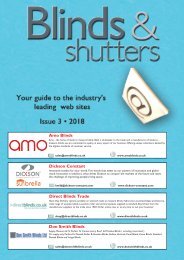Finishing - January-February 2020
Create successful ePaper yourself
Turn your PDF publications into a flip-book with our unique Google optimized e-Paper software.
40 AEROSPACE
Are you settling for
the second best?
For many high precision industries such as
aerospace, medical, automotive and
defence, industrial parts cleaning plays a
crucial role in quality assurance during the
production process. Inadequate degreasing
can have a disruptive effect on many
subsequent processes. Nevertheless, we see
far too many companies using a suboptimal
cleaning solution in their operations. There are
various reasons behind this. Some businesses
simply lack the knowledge and expertise to
competently evaluate potential options. Others
have been relying on one particular method
for so long that they are not aware of
alternative solutions. And in many cases, plant
operation managers have such deep-seated
misconceptions about certain cleaning
technology that they categorically rule out
their use despite their proven cleaning quality.
A case in point is solvent cleaning.
Although solvents have long been
recognised to be one of the most effective
cleaning agents, especially for highly
specialised sectors, there is no shortage of
myths surrounding their use. Common
misunderstandings conclude that solvent
degreasing is a dirty job; that it is bad for the
environment or it is dangerous for workers.
These beliefs are in fact nothing more than
misconceived ideas. In particular, the
unfounded fear about managing solvent risk
and concerns about meeting health, safety
and environmental requirements has deterred
companies from the use of solvents, and
therefore robbed them of the opportunity to
reap the many tangible benefits solvent
cleaning delivers.
Nowadays, solvent degreasing is well
established in fully closed cleaning systems.
Perhaps surprising to most, its efficiency is
often superior to alternatives promoted as
"more sustainable", since it does not require
significant energy for drying and no water is
needed in the process. Closed cleaning
technology with internal solvent recovery
further reduces the amount of waste to be
recycled, thereby lowering overall cleaning
costs. In addition, the supply, transport and
storage of solvent in safety systems enables
safe and responsible handling towards people,
air, and soil as well as legal compliance. With
sufficient worker training and risk
management measures, handling solvent does
not represent a risk factor any different than
other potential hazard in the workplace.
When it comes to industrial parts cleaning,
there is no one-size-fits-all approach. No one
cleaning method would work universally. It
takes a comprehensive evaluation to identify
the most suitable cleaning method where
numerous factors must be carefully
considered, such as the types of metals and
contamination, degree of complexity of
components to be cleaned, volume of parts,
production oil used, regulations compliance
and approved substances, to name just a few.
Companies would be doing themselves a
huge disfavor if they immediately rule out
established cleaning methods like solvent
cleaning without even taking an objective
evaluation of its advantages and risks, and the
best approach to keep the balance.
Optimal parts cleaning process goes far
beyond than just trying to achieve cleaning
excellence. With the right combination of
machine technology, cleaning agent and
application technology, the critical cleaning
process can be transformed into a value
adding step that drive operational and
resource efficiency as well as significant time
and cost savings – in short, competitive edge
that can directly impact the bottom line.
The most important question remains: Is
your metal cleaning process a bottleneck in
your manufacturing or is it creating value for
your entire operation? And are you exploiting
the full potential of your parts cleaning
process to propel your business forward – or
are you just settling for the second-best
option? It might be time for a proper rethink.
Finishing - January/February 2020

















